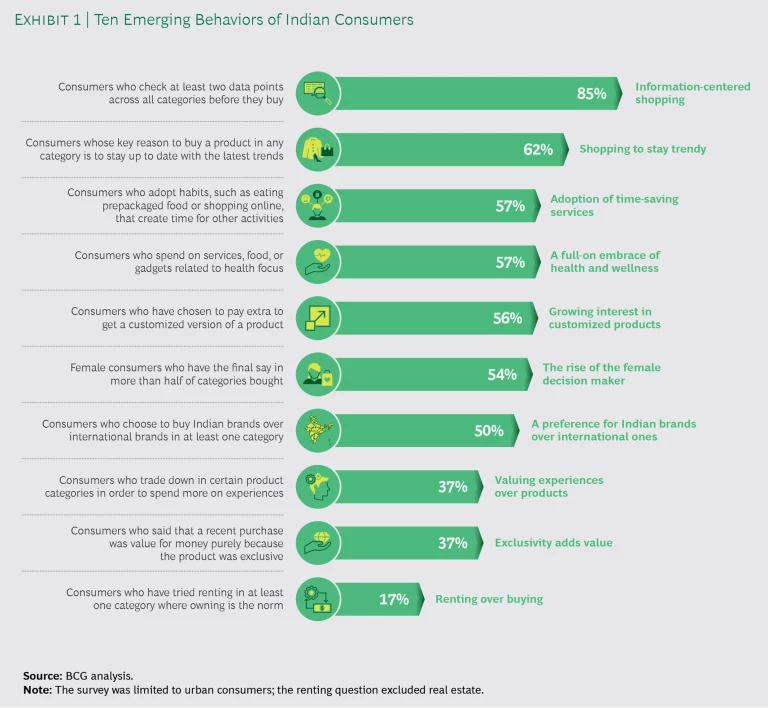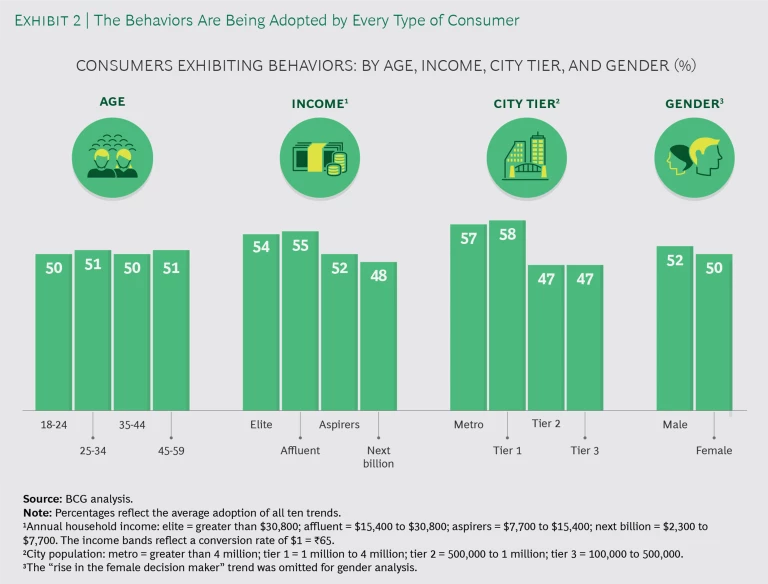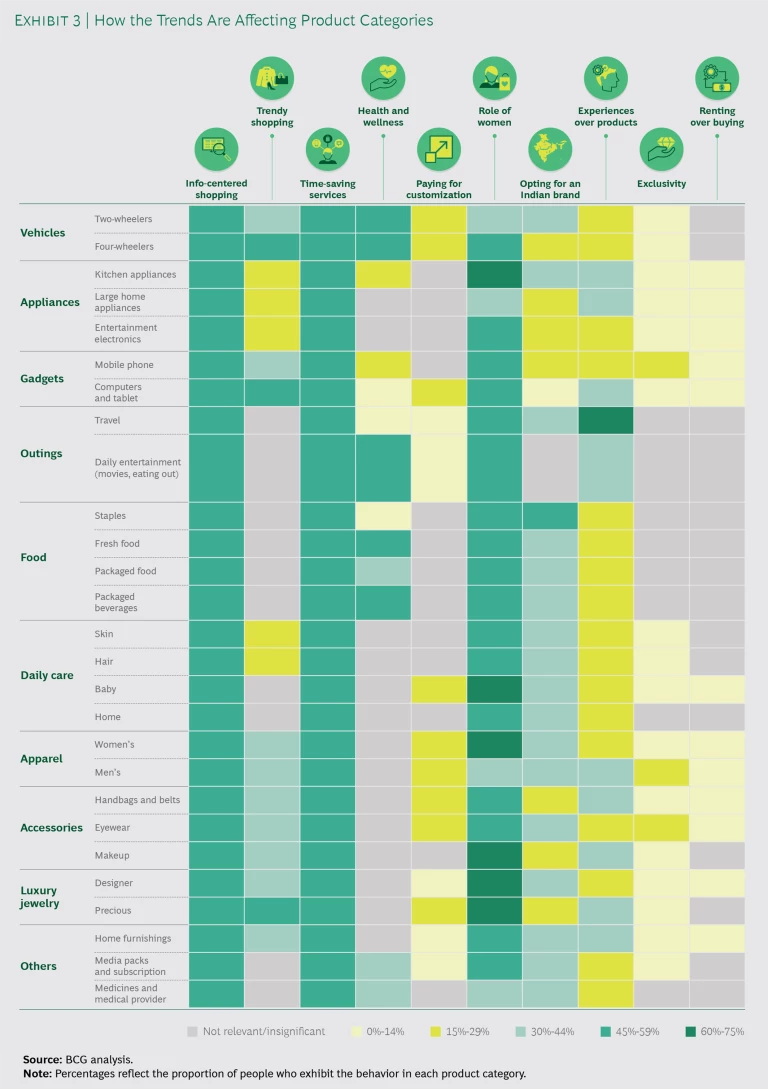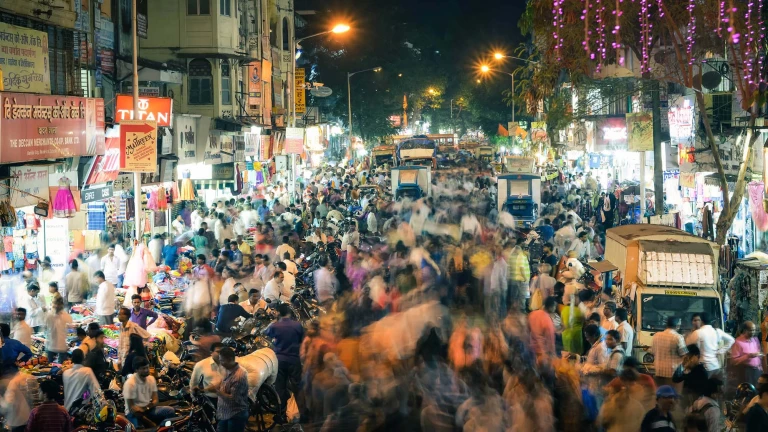Trisha and Samir, a married couple in their early 30s, grew up in typical middle-class Indian households.
Attitudes are changing as a result of rising incomes and exposure to new ideas and technologies.
But attitudes in India are changing as a consequence of rising incomes and of exposure to new ideas and technologies. For Trisha and Samir—and the tens of millions of Indians like them—the interest in spending on traditional things, such as the purchase of a home, has fallen. Increasingly, people are spending more on experiences, customized products, and time-saving services.
These trends are underscored in a new survey by Boston Consulting Group’s Center for Customer Insight (CCI). Seeking to shed light on consumer trends in urban parts of India, CCI surveyed people living in the biggest metro areas, as well as in tier 1, tier 2, and tier 3 cities. (See “A Survey Designed to Uncover Future Consumer Trends.”) The findings have implications for a wide variety of B2C companies that want to succeed in India, where the level of consumer spending is on track to become the world’s third highest within a decade.
A SURVEY DESIGNED TO UNCOVER FUTURE CONSUMER TRENDS
A SURVEY DESIGNED TO UNCOVER FUTURE CONSUMER TRENDS
Two types of research formed the basis of this article. The first was a set of focus groups comprising roughly 200 people. These focus groups were used to test certain hypotheses about how consumer attitudes are changing and to generate a short list of trends to investigate more fully.
The second part of the research—which was undertaken shortly after the focus groups—was a quantitative survey of 5,000 urban consumers in cities that ranged in size from Mumbai, with more than 19 million inhabitants, to Panipat, with roughly 300,000. The quantitative surveys were conducted in person and had quotas that allowed analysis by respondents’ age, gender, and income, as well as by size of city.

Shining a Light on India’s Urban Consumers
The study revealed both well-known and less well-known trends. An example of a well-known trend is information-centered shopping , in which consumers search for a great deal of information about a product or service before putting down money; an example of a less well-known trend is a preference for renting over buying. (See Exhibit 1.)

Most surprising, however, is that the ten new trends have quickly taken root in almost all Indian cities and across all demographic segments. The behaviors can be found among men and women of all ages, at every income level, and in every size of city. (See Exhibit 2.) The ubiquity of the behaviors has important implications for companies trying to expand their bases of business in India. Here’s a closer look at these trends.
Information-Centered Shopping. People in Indian cities now treat information gathering as an integral part of the shopping experience. Eighty-five percent of consumers check at least two data points (beyond prices and discounts) when they’re buying something, and roughly 50% do some sort of online research. Among the sorts of information that people look for are product reviews, manufacturing and expiration dates, and how a product compares with alternatives in terms of features. “I need to read the pack before buying,” said a 38-year-old housewife from Gurugram. This is true even for a simple product, such as yogurt, which she noted can come in many varieties. “You need to know what you’re buying.”
Shopping to Stay Trendy. A desire to be in sync with the latest trends is increasingly driving purchases among Indian consumers. More than 60% of respondents said that in the past year, in at least one category, they had purchased something because it was trendy and they felt like upgrading—not necessarily because they needed a replacement.
Not surprisingly, the categories that ranked high for trendiness had products that tended to be those that someone might well see and notice. For instance, in the year leading up to the survey, 58% of people buying gadgets such as tablets and laptop computers, and 53% of consumers buying four-wheel vehicles, purchased their products just to stay up to date with the latest in the market.
Adoption of Time-Saving Products and Services. After signing a lease on a new flat, a young couple in Delhi bought all their furniture online from Urban Ladder, thus avoiding the need to make multiple shopping excursions in the scorching summer heat. A young family in Bhubaneshwar contracted out the refurbishment and painting of their house to an end-to-end provider to avoid the hassle of dealing with multiple contractors.
These people are among the 57% of urban Indians who said that, in the recent past, they have paid for a product or service that saves them time. And they do this even if what they’re buying costs more than the alternative or causes them to underuse an existing resource. A car-owning businessman, for instance, said that he commutes to work in a taxi so he can catch up with phone calls instead of having to fight with traffic and then look for a parking space.
While this trend can be seen everywhere, it is most prevalent among affluent consumers and in metro and tier 1 cities.
A Full-On Embrace of Health and Wellness. Health consciousness has seeped into the national conversation in recent years, and our survey shows that 57% of consumers now spend on health and wellness. This includes 46% of consumers who are spending on services such as health checkups, gym memberships, and diet consultations, and 40% of consumers who are spending on healthier food.
The trend toward health and wellness is also affecting non-health-related industries in some unpredictable ways. For instance, almost half of respondents said that they now occasionally walk to a destination instead of taking a cab, and 40% have cut down on their media and online use to create more time for physical activities.
Interestingly, for a majority of the Indians who spend on fitness activities, the motivation is less to feel healthy than to look healthy. “The biggest motivation is to lose weight and look attractive,” said a 28-year-old working woman from Jaipur. “My friend recently went on a crash diet right before her wedding to look slim in pics.”
The pleasure of being perceived favorably by others was a subtheme throughout the survey. While it was mentioned more frequently by younger consumers, it was a motivation, to one degree or another, for members of every age group in India.
Growing Interest in Customized Products. Mass-produced offerings have long dominated the Indian market. But in certain product categories, there’s also now a belief that what one buys should reflect one’s individual preferences and needs—even if one has to pay extra for the difference: 56% of our survey respondents paid a premium for customization in at least one category in the 12 months prior to the survey.
Customizations were most common in the women’s apparel category: 27% of women said that they had paid for some sort of customization—such as fabric swatches, designs, or colors—beyond fit or basic alterations. Men’s apparel, at 24%, wasn’t far behind. An IT professional told us that he decided to buy a custom-made shirt after noticing that his boss often wore such shirts. “I love the fact that it is made exclusively for me,” the professional said. “The fact that it gives me the perfect fit is an added plus.”
Requests for custom features in two-wheel and four-wheel vehicles are also common: more than 20% of people who buy these products opt for some sort of customization. The payoff is partly the praise that other people shower on the customizer. A 29-year-old from Jamnagar recalled that he had a special music system installed in his car by a local vendor. Since then, whenever he and his friends are planning a road trip, they always choose his car to travel in.
The Rise of the Female Decision Maker. A few years ago, the gender gap in secondary education in India, which had been narrowing for decades, disappeared altogether. On the heels of this change has come another: women now have the final say in the majority of household purchasing decisions (54% of the time).
And that final say isn’t limited to categories traditionally targeted to women. Fifty-one percent of Indian women make the ultimate decision about their families’ leisure travel plans and 44% have the final say about bikes and scooters. Moreover, women shop differently from men. For example, when shopping for gadgets, men will look for a popular brand that they’ve researched online, while women will visit multiple stores and take the time to hear what store associates have to say.
A Preference for Indian Brands over International Ones. It’s no accident that in Indian retail stores, locally produced products have prominent shelf positions: 50% of Indian consumers will bypass international brands in favor of an Indian brand in at least one category.
The trend is strongest in food, including staples and packaged beverages (where the preference for Indian brands is 47% and 37%, respectively). Personal and home care products are other areas where the trend is visible, with about one-third of respondents consciously buying Indian brands instead of international ones. “I only trust Indian cosmetic brands,” is the way one 30-year-old Mumbaikar put it. “They use Indian herbs and Ayurvedic ingredients, which really suit the Indian skin better than the chemicals used by international brands.”
The preference for Indian brands is expressed to about the same degree in apparel, mainly because of the widespread belief that such brands do a better job of considering Indian consumers’ needs and therefore deliver superior results. And it is particularly prevalent among the oldest consumers we surveyed, who were 45 to 59 years old: 58% of these consumers try to buy Indian brands in at least one category.
Valuing Experiences over Products. About four-fifths (77%) of the respondents paid for three or more different types of experience last year. Travel was the most common paid experience, and entertainment—including concerts, plays, and movies—was second.
Most respondents (53%) said that increased household income allows them to pay for the experiences they are having. But higher income isn’t the only enabler of experiences. A surprising proportion of urban Indians—37%—said that they are financing their experiences by trading down in certain product categories, including jewelry, mobile phones, apparel, and home furnishings. The preference for experience over products was best expressed by an interviewee who said, “Whenever I want to pamper myself, I buy a massage instead of clothes.”
For many survey participants, part of what they like about experiences is all the positive attention it brings them on social media. “If you do something crazy like sky diving or scuba diving and don’t update it on Instagram, it’s not the same feeling,” said a 30-year-old who has his own textile business in Jaipur.
There’s a belief that what one buys should reflect one’s individual preferences and needs--even if one has to pay extra for the difference.
Exclusivity Adds Value. The traditional notions of best price and of good quality at a reasonable price continue to hold sway among Indian consumers across the majority of categories. In certain categories, however, exclusivity is now seen as enhancing a product’s value. For example, 37% of urban Indians value exclusivity with regard to eyewear, apparel, and select electronic items. Fourteen percent of female consumers said that an item of apparel they had purchased provided value for the money because it was an exclusive brand that increased their social status. One focus group participant noted the immense pleasure she takes in people’s responses to her limited-edition Titan Raga watch.
Renting over Buying. Presented with a list of products that are traditionally purchased—as varied as kitchen appliances, clothes, and furniture—17% of our survey respondents said that they had rented, rather than purchased, one of the items in the past year, while a quarter said that they would consider renting in the future. In part, this is a function of supply: India has a growing number of high-profile startups that offer rentals in big cities in a variety of categories.
But simply having the option to rent is only part of what’s driving the trend in India. Among lower-income respondents in our survey, the main motivation to rent was affordability. People in the higher-income segments rent for different reasons. One is the flexibility that renting enables: young professionals on temporary assignments, for example, prefer to rent their furniture. Another reason is variety. For example, Rahul, a 35-year-old technophile from Bangalore, found a website from which he can rent a new smartphone every few months. “I hate to be stuck with one phone for years,” he said.
What’s more, the urge to switch things up is not limited to consumers in India’s metropolitan cities. A 39-year-old woman told us that she is waiting for apparel rentals to become widely available in Jamnagar, the tier 1 city where she lives. There are numerous social occasions in “cities like ours,” she said, and “people really talk about what the other person was wearing. No one likes to repeat their clothes.”

The Trends Through a Different Lens
Because the survey questions covered 30 categories, it was possible to do a detailed analysis of the trends across product segments. (See Exhibit 3.) While each of these trends is gaining steam, their current penetration across categories varies. For instance, nascent trends, such as the more favorable views of renting and exclusivity, occur only in certain categories. By contrast, more established trends, such as looking to save time and taking a more information-centric approach to shopping, can be found in any category of product a consumer in India might be considering.
Questions to Ask as India Evolves
For Indian companies and multinationals alike, the right response to the country’s budding consumer trends will depend on the peculiarities of each company’s product segments and how they are changing. Standing pat, however, isn’t an option. Here are the key questions for B2C companies in India:
- Are you actively monitoring the changes in India’s consumer landscape? Given the fast pace of change, it is important for companies to devise mechanisms to continuously track these trends and spot new ones.
- Do you have a clear understanding of the trends that are most relevant to your category? Each of these trends impacts different categories differently. You should understand which trends are most relevant for your categories and determine the nature and degree of their impact.
- Have you thought through the implications of the trends for your business? Some of these trends may offer opportunities for your business; others may pose a serious threat if not proactively thought through and managed. It is critical to be aware of these differences and respond accordingly.
- Are you actively adjusting to the new consumer behaviors, or do you assume that you’ll be able to catch up at a later stage? Taking a wait-and-see approach is a mistake. If you’re not already trying new marketing tactics, you run the risk of obsolescence.





